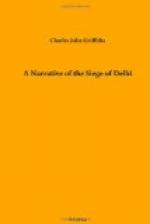It was my invariable custom to wear as a kammerband or girdle folds of muslin round my waist for the protection of the liver and spleen, and in this I placed the articles I carried away. My friend procured a small cart, in which he deposited the loot and drove to the house of one of the agents, while I, encumbered as I was, with difficulty mounted my horse and rode towards the magazine. I could not but feel nervous and abashed when thinking of the riches concealed about my person, at last working myself up to such a pitch of excitement that I imagined all I met were cognizant of my good fortune; and on entering the gates of the magazine, I fancied I heard one of our men say to his comrade, “Well! that fellow, at any rate, has plenty of loot about him.”
Our next great find, though by no means so lucrative as the first, brought a large accession to the prize fund. It occurred to me, through calling to recollection the story of the treasures concealed in the Hindoo idol at Somnath which was broken open by Sultan Mahmoud in the eleventh century, that possibly the same kind of receptacle might disclose a like prize, though on a smaller scale, among the numerous temples scattered through the city of Delhi.
Acting on this idea, we one day entered a small Hindoo temple situated not far from the Chandni Chauk. The shrine was gaudily decorated; but after a prolonged search, we found nothing of any value. A hideous idol stood on a raised structure in the centre of the building, and was soon demolished in iconoclastic style with our hammers. The base of the idol was formed of chunam (a kind of cement), and into this we dug with our small pickaxes. Soon a ringing sound from a blow disclosed a large silver casket imbedded in the chunam, and this, after some little trouble, we extricated from its position. Forcing the casket open, our sight was regaled by a brilliant show of jewels and gold—diamonds, rubies, and emeralds—two of the latter species being uncut, but of great size, pearls larger than any we had yet seen, and gold ornaments of every description, chains, bracelets, bangles, and a few gold mohurs. We were quite alone in the temple, and after feasting our eyes on the treasures and selecting a few objects for our own benefit, N—— took the casket to the prize agent, telling him where we had found it, and recommending a search in such localities, which recommendation, no doubt, was carried into effect among other Hindoo temples in the city.
When first entering a house during our search, we at once made ourselves acquainted with the creed of its former inhabitants. In this there was no difficulty—Korans lying about the floor denoted that the occupants had been Mussulmans, while many indications, such as idols, a different arrangement of the furniture, and other signs with which we became conversant, proved the influence of the rival Hindoo race. There was a very cogent reason for this investigation on our part—the Mohammedans




